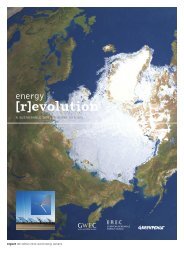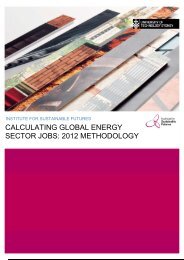download the mexico energy revolution scenario
download the mexico energy revolution scenario
download the mexico energy revolution scenario
Create successful ePaper yourself
Turn your PDF publications into a flip-book with our unique Google optimized e-Paper software.
This chapter describes <strong>the</strong> range of technologies available now and<br />
in <strong>the</strong> future to satisfy <strong>the</strong> world’s <strong>energy</strong> demand. The Energy<br />
[R]evolution <strong>scenario</strong> is focused on <strong>the</strong> potential for <strong>energy</strong> savings<br />
and renewable sources, primarily in <strong>the</strong> electricity and heat<br />
generating sectors.<br />
fossil fuel technologies<br />
The most commonly used fossil fuels for power generation around<br />
<strong>the</strong> world are coal and gas. Oil is still used where o<strong>the</strong>r fuels are<br />
not readily available, for example islands or remote sites, or where<br />
<strong>the</strong>re is an indigenous resource. Toge<strong>the</strong>r, coal and gas currently<br />
account for over half of global electricity supply.<br />
coal combustion technologies In a conventional coal-fired power<br />
station, pulverised or powdered coal is blown into a combustion<br />
chamber where it is burned at high temperature. The resulting heat<br />
is used to convert water flowing through pipes lining <strong>the</strong> boiler into<br />
steam. This drives a steam turbine and generates electricity. Over<br />
90% of global coal-fired capacity uses this system. Coal power<br />
stations can vary in capacity from a few hundred megawatts up to<br />
several thousand.<br />
A number of technologies have been introduced to improve <strong>the</strong><br />
environmental performance of conventional coal combustion. These<br />
include coal cleaning (to reduce <strong>the</strong> ash content) and various ‘bolton’<br />
or ‘end-of-pipe’ technologies to reduce emissions of particulates,<br />
sulphur dioxide and nitrogen oxide, <strong>the</strong> main pollutants resulting<br />
from coal firing apart from carbon dioxide. Flue gas<br />
desulphurisation (FGD), for example, most commonly involves<br />
‘scrubbing’ <strong>the</strong> flue gases using an alkaline sorbent slurry, which is<br />
predominantly lime or limestone based.<br />
More fundamental changes have been made to <strong>the</strong> way coal is<br />
burned to both improve its efficiency and fur<strong>the</strong>r reduce emissions<br />
of pollutants. These include:<br />
• integrated gasification combined cycle: Coal is not burned<br />
directly but reacted with oxygen and steam to form a syn<strong>the</strong>tic<br />
gas composed mainly of hydrogen and carbon monoxide. This is<br />
cleaned and <strong>the</strong>n burned in a gas turbine to generate electricity<br />
and produce steam to drive a steam turbine. IGCC improves <strong>the</strong><br />
efficiency of coal combustion from 38-40% up to 50%.<br />
• supercritical and ultrasupercritical: These power plants operate<br />
at higher temperatures than conventional combustion, again<br />
increasing efficiency towards 50%.<br />
• fluidised bed combustion: Coal is burned in a reactor<br />
comprised of a bed through which gas is fed to keep <strong>the</strong> fuel in a<br />
turbulent state. This improves combustion, heat transfer and <strong>the</strong><br />
recovery of waste products. By elevating pressures within a bed, a<br />
high-pressure gas stream can be used to drive a gas turbine,<br />
generating electricity. Emissions of both sulphur dioxide and<br />
nitrogen oxide can be reduced substantially.<br />
• pressurised pulverised coal combustion: Mainly being<br />
developed in Germany, this is based on <strong>the</strong> combustion of a finely<br />
ground cloud of coal particles creating high pressure, high<br />
temperature steam for power generation. The hot flue gases are<br />
used to generate electricity in a similar way to <strong>the</strong> combined<br />
cycle system.<br />
O<strong>the</strong>r potential future technologies involve <strong>the</strong> increased use of coal<br />
gasification. Underground Coal Gasification, for example, involves<br />
converting deep underground unworked coal into a combustible gas<br />
which can be used for industrial heating, power generation or <strong>the</strong><br />
manufacture of hydrogen, syn<strong>the</strong>tic natural gas or o<strong>the</strong>r chemicals.<br />
The gas can be processed to remove CO2 before it is passed on to<br />
end users. Demonstration projects are underway in Australia,<br />
Europe, China and Japan.<br />
gas combustion technologies Natural gas can be used for<br />
electricity generation through <strong>the</strong> use of ei<strong>the</strong>r gas or steam<br />
turbines. For <strong>the</strong> equivalent amount of heat, gas produces about<br />
45% less carbon dioxide during its combustion than coal.<br />
Gas turbine plants use <strong>the</strong> heat from gases to directly operate <strong>the</strong><br />
turbine. Natural gas fuelled turbines can start rapidly, and are<br />
<strong>the</strong>refore often used to supply <strong>energy</strong> during periods of peak<br />
demand, although at higher cost than baseload plants.<br />
Particularly high efficiencies can be achieved through combining<br />
gas turbines with a steam turbine in combined cycle mode. In a<br />
combined cycle gas turbine (CCGT) plant, a gas turbine<br />
generator produces electricity and <strong>the</strong> exhaust gases from <strong>the</strong><br />
turbine are <strong>the</strong>n used to make steam to generate additional<br />
electricity. The efficiency of modern CCGT power stations can be<br />
more than 50%. Most new gas power plants built since <strong>the</strong> 1990s<br />
have been of this type.<br />
At least until <strong>the</strong> recent increase in global gas prices, CCGT power<br />
stations have been <strong>the</strong> cheapest option for electricity generation in<br />
many countries. Capital costs have been substantially lower than<br />
for coal and nuclear plants and construction time shorter.<br />
carbon reduction technologies Whenever a fossil fuel is burned,<br />
carbon dioxide (CO2) is produced. Depending on <strong>the</strong> type of power<br />
plant, a large quantity of <strong>the</strong> gas will dissipate into <strong>the</strong> atmosphere<br />
and contribute to climate change. A hard coal power plant<br />
discharges roughly 720 grammes of carbon dioxide per kilowatt<br />
hour, a modern gas-fired plant about 370g CO2 /kWh. One method,<br />
currently under development, to mitigate <strong>the</strong> CO2 impact of fossil<br />
fuel combustion is called carbon capture and storage (CCS). It<br />
involves capturing CO2 from power plant smokestacks, compressing<br />
<strong>the</strong> captured gas for transport via pipeline or ship and pumping it<br />
into underground geological formations for permanent storage.<br />
While frequently touted as <strong>the</strong> solution to <strong>the</strong> carbon problem<br />
inherent in fossil fuel combustion, CCS for coal-fired power stations<br />
is unlikely to be ready for at least ano<strong>the</strong>r decade. Despite <strong>the</strong><br />
‘proof of concept’ experiments currently in progress, as a fully<br />
integrated process <strong>the</strong> technology remains unproven in relation to<br />
all of its operational components. Suitable and effective capture<br />
technology has not been developed and is unlikely to be<br />
commercially available any time soon; effective and safe long-term<br />
storage on <strong>the</strong> scale necessary has not been demonstrated; and<br />
serious concerns attach to <strong>the</strong> safety aspects of transport and<br />
injection of CO2 into designated formations, while long term<br />
retention cannot reliably be assured.<br />
8<br />
<strong>energy</strong> technologies | FOSSIL FUEL TECHNOLOGIES<br />
89



![Energy [R]evolution - European Commission](https://img.yumpu.com/49109324/1/184x260/energy-revolution-european-commission.jpg?quality=85)


![5905 gp [eu rev]csfr4.qxd - Energy [R]evolution](https://img.yumpu.com/42305023/1/184x260/5905-gp-eu-revcsfr4qxd-energy-revolution.jpg?quality=85)


![5905 gp [eu rev]csfr4.qxd - Energy [R]evolution](https://img.yumpu.com/28729264/1/184x260/5905-gp-eu-revcsfr4qxd-energy-revolution.jpg?quality=85)